
Scydmaeninae are a subfamily of small beetles, commonly called ant-like stone beetles or scydmaenines. These beetles occur worldwide, and the subfamily includes some 4,500 species in about 80 genera. Established as a family, they were reduced in status to a subfamily of Staphylinidae in 2009
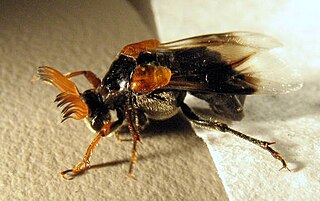
Ripiphoridae is a cosmopolitan family of some 450 described species of beetles sometimes called "wedge-shaped beetles". Ripiphoridae are unusual among beetle families in that many species are hypermetamorphic parasitoids, an attribute that they share with the Meloidae. Members of the family differ in their choice of hosts, but most attack various species of bees or wasps, while some others attack cockroaches or beetles. Many species of Ripiphoridae have abbreviated elytra, and flabellate or pectinate antennae.

Cryptophagidae is a family of beetles with representatives found in all biogeographic realms. Members of this family are commonly called silken fungus beetles and both adults and larvae appear to feed exclusively on fungi although in a wide variety of habitats and situations, such as rotting wood and shed animal fur and feathers. These beetles vary from about 1 to 11 millimeters long, and usually have an oval body shape with a slight "waist".
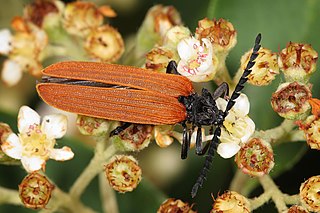
The Lycidae are a family in the beetle order Coleoptera, members of which are commonly called net-winged beetles. These beetles are cosmopolitan, being found in Nearctic, Palearctic, Neotropical, Afrotropical, Oriental, and Australian ecoregions.

Melyridae are a family of beetles of the superfamily Cleroidea.
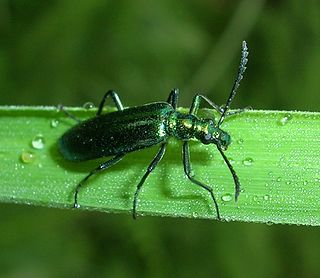
Prionoceridae is a small family of beetles, in the suborder Polyphaga. They form a group within the cleroid beetles and were formerly treated as a subfamily (Prionocerinae) within the family Melyridae. Very little is known of their life history but most species are pollen feeders as adults and occur in large numbers during spring or the host flowering season. Larvae are predatory or feed on decomposing wood.

Scirtidae is a family of beetles (Coleoptera). These beetles are commonly referred to as marsh beetles, as the larvae are typically associated with stagnant water, but can be found in flowing water. Adults prefer decomposing plant material near the water's edge. More than an estimated 600 species are known worldwide, distributed among at least 60 genera.
Bactridium is a genus of root-eating beetles in the family Monotomidae. There are about 18 described species in Bactridium.
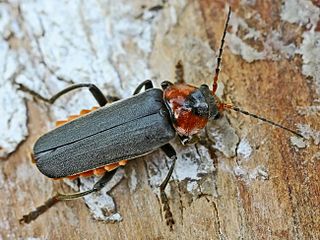
Cantharinae is a subfamily of beetles in the family Cantharidae. There are at least 200 described species in Cantharinae.

Chalepini is a tribe of leaf beetles in the family Chrysomelidae. There are at least 50 genera and 830 described species in Chalepini.

Anamorphidae is a family of beetles in the superfamily Coccinelloidea, formerly included within the family Endomychidae. They are found worldwide. Like enchomyids, they are fungivores, with adult and larval stages thought to exclusively consume fungal spores.
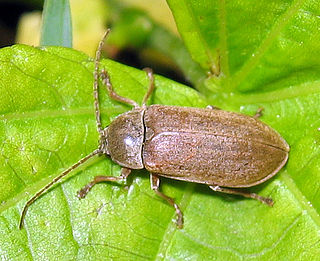
Dascillidae is a family of beetles within the clade Elateriformia. There are about 100 extant species in 11 genera, which are found worldwide. Dascillidae together with Rhipiceridae form the super family Dascilloidea.

Artematopodidae is a family of soft-bodied plant beetles in the superfamily Elateroidea. They are mostly found in understory forest foliage. The life history of the group is obscure, larvae of the genera Eurypogon and Macropogon likely feed on moss, while the larvae of Artematopus have been fed insect remains. The oldest fossils of the family date to the Middle Jurassic.

Throscidae is a family of elateroid beetles found worldwide with around 150 species in 5 extant genera. The larvae are soil-dwelling, siphoning fluid from mycorrhizae attached to trees. The adults are short-lived, with the adult males being noted for a complex mating dance. Like some other elateroids, they are capable of clicking.

Stenochiinae is a subfamily of darkling beetles in the family Tenebrionidae. There are more than 390 genera in Stenochiinae.

Lycinae is a subfamily of net-winged beetles in the family Lycidae.

Malachiini is a large tribe of soft-winged flower beetles in the family Melyridae.
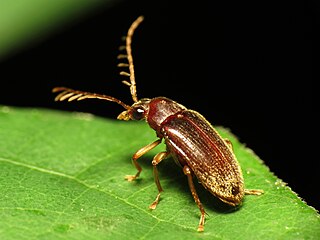
Ptilodactyla is a genus of toe-winged beetles in the family Ptilodactylidae. There are around 380 described species in Ptilodactyla, which is about 70% of all species in the family. However, it may be subject to divisions in the future and there are likely many more undescribed species.

Scirtes is a genus of marsh beetles in the family Scirtidae. There are more than 80 described species in Scirtes.



















